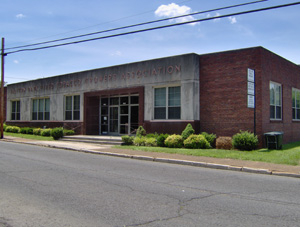
Dark Tobacco District Planters' Protective Association
Hoping for relief from economic hardship, tobacco growers in western Kentucky and northern Middle Tennessee formed the Dark Tobacco District Planters’ Protective Association of Kentucky and Tennessee (PPA) on September 24, 1904. A steady decline in dark-fired tobacco prices since the turn of the century had brought deprivation and suffering to the farmers of the region. The area had endured periodic depressions caused by low tobacco prices since the Civil War, prompting many growers in the region to support the Grangers, Greenbackers, Farmers’ Alliance, Populist Party, and other organizations promising relief from agrarian problems.
Although the principal goal of the PPA was to raise tobacco prices by the cooperative marketing of the crop, the organization also strove to make the federal and state governments more responsive to agrarian needs and to convince tobacco growers to embrace the gospel of diversification, science, and efficiency. The PPA operated for over a decade and was one of the nation’s most successful tobacco cooperatives until the formation of the various New Deal tobacco associations. During the PPA’s existence tobacco prices rose and remained at profitable levels. Remembering the fate of the Southern Farmers’ Alliance and other earlier farm organizations, the PPA refused to become embroiled in party politics.
Even though the PPA operated in over twenty counties in Tennessee and Kentucky, the organization was dominated by four growers from Robertson County, Tennessee: Joseph E. Washington, Felix G. Ewing, Charles H. Fort, and Joel B. Fort. Ewing, who emerged as the cooperative’s most important leader, lived on the Glenraven plantation near Cedar Hill. He served as chairman of the cooperative’s executive committee and so dominated the organization that it was often called the “Ewing Association.” PPA officials contended that collusion among buyers was the primary factor suppressing tobacco prices. They identified the American Tobacco Company and the Italian Regie as the most important culprits and called this monopoly of buyers “the Trust.” The goal of the cooperative was to convince growers to sign pledges to withhold their crops from “the Trust” and sell only through the farmers’ organization. When the early efforts of the PPA proved ineffective in convincing tobacco companies to buy through the cooperative, some disgruntled growers formed a second organization of “night riders.” This covert group used violence and intimidation to raise tobacco prices, initiating a period known as the Black Patch War. The joint efforts of the PPA and the night riders contributed to a general rise in prices.
The PPA declined in strength after 1908. Growing popular opposition to the violence, Trust incentives designed to lure growers away from the PPA, Ewing’s increasingly dictatorial management style, and the increased prosperity that came with higher prices contributed to the deterioration of the organization. The PPA officially ended in 1914 when World War I closed most European markets for dark-fired tobacco, which was primarily an export crop.
Suggested Reading
Rick Gregory, “Robertson County and the Black Patch War, 1904-1909,” Tennessee Historical Quarterly 39 (Fall 1980): 341-59 and “Desperate Farmers: The Dark Tobacco District Planters Protective Association of Kentucky and Tennessee, 1904-1914,” (Ph.D. diss., Vanderbilt University, 1989); Christopher Waldrep, “Planters and Planters Protective Association in Kentucky and Tennessee,” Journal of Southern History 52 (1986): 565-88



